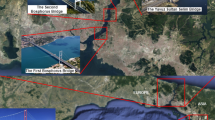Conclusions
-
1.
Justification of the design and construction of the Krasnoyarsk station required a broad range of scientific investigations. Organization of the investigations and adoption of the results for improving reliability of the installations and improving the engineering economic indices of the station were possible through the close cooperation of design and construction engineers, scientists, and operational personnel.
-
2.
A considerable part of the results of the investigations is of importance not only for the Krasnoyarsk station, but also for several large hydropower installations under construction, in the design stage, and scheduled for future construction.
-
3.
Krasnoyarsk hydroelectric station, the largest in the world, embracing the experience gained in hydropower construction in the USSR, was and continues to be one of the main experimental bases of Soviet hydraulic engineering science.
Similar content being viewed by others
Literature Cited
É. K. Aleksandrovskaya, “Stresses in the Krasnoyarsk hydroelectric station dam during construction and preliminary operation,” No. 4 (1971).
L. M. Garkun and É. Ya. Gur'eva (Siberian branch), “Method for determining the statistical characteristics of concrete homogeneity,” No. 9 (1969).
A. P. Bechin, “Drying the rock excavations of hydroschemes,” No. 8, (1966).
V. V. Blinkov, Yu. N. Gusev, and É. K. Aleksandrovskaya, “Results of full-scale investigations of the Krasnoyarsk station turbine penstocks,” No. 4 (1971).
A. E. Bochkin, E. E. Liskun, V. A. Koren'kov, G. A. Ozolin, and S. I. Korol', “Experience in the temporary retention of the ice flow on the Enisei river before the Krasnoyarsk station installations in construction,” No. 4 (1968).
A. E. Bochkin, E. A. Dolginin, N. A. Eliseev, and V. M. Starkov, “Calculation of unstable motion by the approximation method when investigating scour in the tailrace of the Krasnoyarsk hydroelectric station,” No. 11 (1969).
A. E. Bochkin, E. E. Liskun, A. P. Epifanov, D. M. Kokot, and S. N. Starshinov, “The state of the Krasnoyarsk hydroelectric station dam during the first years of service,” No. 4 (1971).
A. G. Vasilevskii, “Procedure for determining the winter operating regimes of the spillway gates and hydroelectric station trashracks,” No. 9 (1971).
Ts. G. Ginzburg, N. A. Zinchenko, and G. F. Skvortsova, “The concrete of the Krasnoyarsk hydroelectric station dam, No. 2 (1966).
Ts. G. Ginzburg and A. P. Epifanov, “Heat generation of cement in concrete,” No. 1 (1966).
Ts. G. Ginzburg, A. N. Pekhovich, and S. M. Aleinikov, “Rapid hardening additives in hydraulic engineering construction,” No. 4 (1965).
A. P. Dolmatov and S. Z. Neidlin, “Regulation of the temperature regime of the solid concrete mass of the Krasnoyarsk hydroelectric station dam,” No. 11 (1968).
A. P. Dolmatov, V. L. Pavlov, and A. E. Plosk, “Grouting the joints of the Krasnoyarsk hydroelectric station dam,” No. 7 (1970).
A. P. Dolmatov, “Determination of the economic range of coils for cooling solid concrete masses in layers No. 1 (1971).
A. P. Dolmatov, “Measures for regulating the temperature conditions of concrete masonry,” No. 7 (1971).
A. P. Epifanov and I. A. Petrova (Siberian branch),” The temperature regime requirements of solid blocks of columnar cross section, placed on a concrete base of a different age,” No. 8 (1968).
M. A. Zinchenko and L. M. Garkun, “The influence of the transport and storage arrangements on the quality of the aggregate for concrete,” No. 8 (1967).
V. A. Koren'kov, “The results of full-scale observations on ice discharge through the installations of the Krasnoyarsk hydroelectric station,” No. 7 (1970).
A. A. Kruchinina and A. G. Solov'eva, “Experimental investigations into the discharge from the upper to the lower pool under the conditions of high spillway dams on a rock foundation,” No. 8 (1965).
E. A. Lubochkov, “Calculation of the suffosion properties of noncohesive soils employing the nonsuffosion analog,” No. 3 (1968).
N. S. Rozanov and R. G. Konstantinova, “The effect of vertical cracks in the rock foundation on the stress in a solid dam,” No. 2 (1966).
K. I. Smirnov, Ts. G. Ginzburg, and A. P. Epifanov, “The use of pipe cooling for regulating the temperature conditions of the concrete in the Krasnoyarsk hydroscheme dam,” No. 2 (1964).
Ya. P. Mirzaev, “The high-head hydraulic laboratory,” No. 8 (1971).
Additional information
Translated from Gidroteknicheskoe Stroitel'stvo, No. 9, pp. 6–10, September, 1972.
Rights and permissions
About this article
Cite this article
Blinkov, V.V., Skladnev, M.F., Shchaveleb, N.F. et al. Scientific research on the Krasnoyarsk hydroelectric station. Hydrotechnical Construction 6, 827–832 (1972). https://doi.org/10.1007/BF02377851
Issue Date:
DOI: https://doi.org/10.1007/BF02377851




